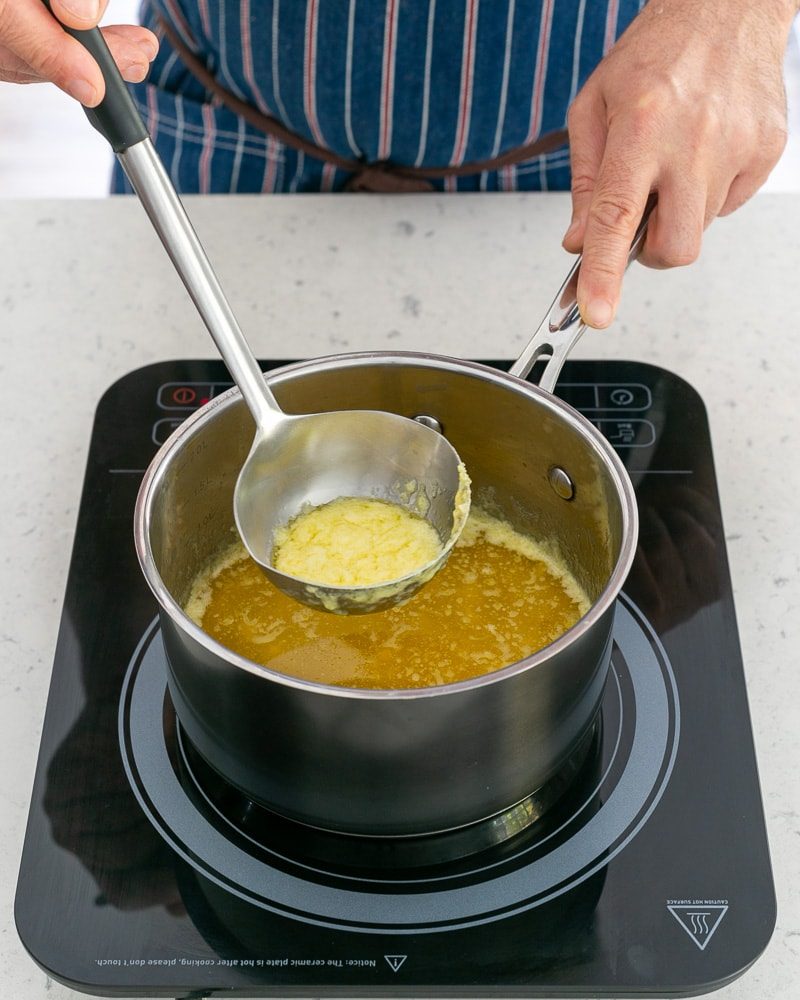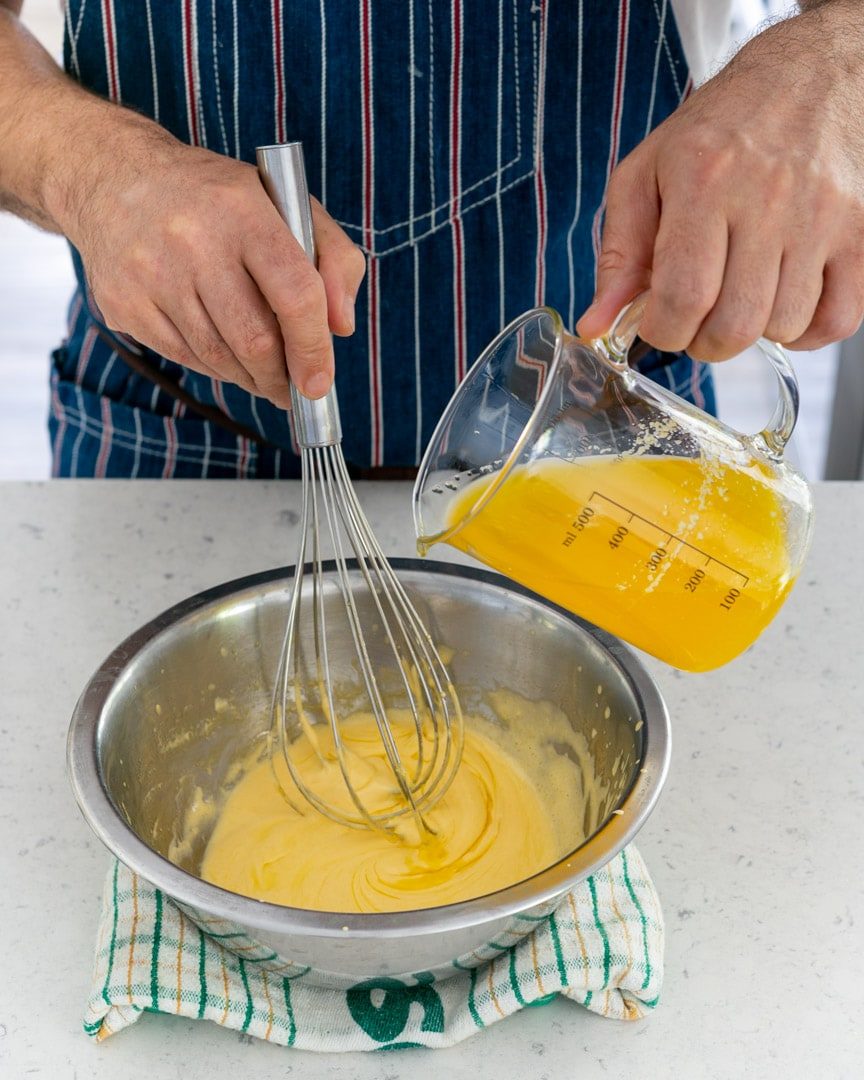This classic French hollandaise sauce is a must have in your recipe collection. We show you step by step how it is not only made the right way but also enjoyed the best way.
I learned to make sauce hollandaise when I started cooking in a professional kitchen. The sauce was part of my section and I basically had to make it on almost every shift during my three year apprenticeship.
Sauce hollandaise is rich, buttery, creamy, one of the most versatile sauces that can be eaten with almost anything. Some well know dishes served or made with this sauce are eggs benedict, white asparagus and lobster thermidor.
Even so making this classic sauce hollandaise from scratch seems like a task, if you follow the recipe and use the right ingredients and understand some basic rules you will succeed. I have encountered many shortcuts on the internet for this sauce and even though I am not against shortcuts, when it comes to hollandaise sauce, I believe it should be made the classic way.
Jump to:
WHAT IS SAUCE HOLLANDAISE
Sauce hollandaise is French for hollandic sauce. The name implies Dutch origins but the actual connection is unclear. It is believed the sauce was made popular in France and it belongs to the classic French mother sauces.

Sauce Hollandaise is an emulsion made from egg yolks and clarified butter. In contrary to mayonnaise sauce which is a cold emulsion, hollandaise is an emulsion between two warm ingredients.
INGREDIENTS IN HOLLANDAISE SAUCE
To make a hollandaise sauce you need the following ingredients:
Egg yolks follow the ratio between egg yolks and butter in this recipe. Never use less than three egg yolks to make hollandaise, the more egg yolks the easier it will get.
Butter use unsalted butter. To make the butter emulsify with the egg yolks, it needs to be clarified. This step basically removes the milk solids from the liquid butter.
Reduction a hollandaise sauce needs a reduction, we show you in the next step how it's done. If you are short on time, you can replace the reduction with your favourite white wine vinegar or lemon juice.

HOLLANDAISE REDUCTION
To make a classic hollandaise sauce we need a reduction. The finished reduction will add a beautiful sweet sour flavour to the actual sauce.
In a pot combine white wine, sliced shallots, bay leaf, thyme, peppercorns and clove and reduce to one fourth. Strain the liquid through a fine sieve and add 2-3 tablespoons of reduction to the egg yolks before whisking them.

CLARIFYING BUTTER
Clarifying butter means heating up the butter on low heat until the milk solids separate from the liquid butter. The milk solid is actual water and it is the white foamy like part you will see separating from the yellow part, which is the butter.

Use a spoon to remove it or just strain through a sieve and leave the white part out.


HOMEMADE HOLLANDAISE SAUCE RECIPE
To make a successful hollandaise sauce follow the steps below
- In a stainless steel bowl, combine the egg yolks with 2 tablespoons reduction and a pinch of salt. Prepare a bain marie (double boiler), the water should be very hot at 60 to 70°C (140 to 158°F) never boil otherwise your eggs will scramble.


- Place the bowl with the eggs on the bain marie and beat the eggs with a whisk rapidly for 5-8 minutes. The eggs will start to increase in volume and become creamy. There is a trick to know if the egg yolks are beaten enough - lift up the whisk, if the egg mixture holds between the wire loops for a few seconds you are ready to add the butter.


- Remove the bowl with the beaten egg yolks and place on a towel to stabilize. Pour the clarified, still warm butter slowly onto the eggs while whisking in a circular motion. Stop a few times to make sure the two elements are well emulsified.

- Add all the butter and season with salt if required.
AS A NOTE: Often the hollandaise sauce seems thick once you have added the clarified butter. To thin the hollandaise sauce, add more reduction or a splash of lemon juice. Alternatively you can add warm water to thin out the sauce.

VARIATIONS OF HOLLANDAISE SAUCE
There are many variations to hollandaise sauce, here are some suggestions:
Add saffron, orange zest and orange juice, great for fish dishes.
With tomatoes and basil to serve with lamb or grilled vegetables.
Add herbs like tarragon, chervil and chives, served over asparagus or poached eggs.

You can even add a twist to the reduction. For example, I have tried a red wine reduction before and the result was excellent!
FAQ'S
How can I fix a split hollandaise sauce?
The fastest way to bring back your hollandaise is to add two tablespoons of warm water in a clean bowl and whisk the split sauce into the warm water. Start slowly, drop by drop, until it comes together and then only whisk in the remaining sauce.
If this doesn't work, start with new egg yolks (about 2), beat them over the water bath and add the split sauce.
How to reheat a hollandaise sauce?
Hollandaise sauce that has cooled down will thicken quickly. To reheat the cold sauce, you have to be extra careful. Slowly reheat on the stove stirring constantly until the sauce is pourable again. Always pour hollandaise on a hot dish, that will help as well.
What can I do if the eggs have scrambled while whisking?
If the eggs have scrambled the temperature was too hot. Unfortunately the only solution is to start again. You really don't want any pieces of scrambled eggs in your sauce hollandaise.
WHAT CAN YOU EAT SAUCE HOLLANDAISE WITH
Due to it's fat content and creamy consistency, this classic hollandaise sauce recipe goes well with many dishes. Here are some suggestions with what to enjoy your homemade sauce with:
Poured on a roasted cauliflower and baked in the oven. The hollandaise will turn brown and taste deliciously nutty.

With a perfectly cooked steak like this bavette steak recipe from another food blogger.
With poached breakfast eggs on sourdough bread.
Paired with this classic white asparagus dish recipe from braised°lazed.
For Oyster Rockefeller, just spoon the hollandaise over oysters and bake in the oven.
Don't all these options just sound delicious? If you enjoy making sauces like beurre blanc, browse through our great range of sauce recipes and watch the sauce story. You will find some great inspiration in our chef's pantry

Hollandaise Sauce Recipe
Equipment
- small pot
- stainless steal bowl
- whisk
Ingredients
for the reduction
- 250 milliliters white wine
- 2 small shallots peeled and sliced
- 2 thyme sprigs
- 8 black peppercorns
- 1 bay leaf
- 1 clove
for the clarified butter
- 300 gram unsalted butter
for the hollandaise sauce
- 4 egg yolks
- salt
Instructions
for the reduction
- Combine all ingredients in a pot. Bring to a simmer on medium heat and reduce to one quarter.
- Strain through a fine chinois and keep aside.
for the clarified butter
- In a small pot melt the butter on low heat. Once the butter is hot enough and starts bubbling the milk solids in form of white foam will come to the surface. Use a spoon to skim the white parts.
- The butter will be clarified if no more white foam appears and the bubbling of the butter stops. Strain the butter through a fine sieve and keep aside.
for the hollandaise sauce
- In a stainless steel bowl combine the egg yolks with 2 tablespoons of the reduction and a pinch of salt.
- Prepare a pot with hot water. The water should be between 60 to 70°C (140 to 158°F), don't let it get too hot otherwise the egg will scramble.
- Place the bowl with the eggs on the water bath (pot with hot water) and beat the eggs with a whisk rapidly for 5-8 minutes. The eggs will start to increase in volume and become creamy. To know if the egg yolks are whisked enough, lift up the whisk. If the egg mixture holds between the wire loops for a few seconds you are ready to add the butter.
- Remove the bowl with the egg mixture and place on a towel to stabilise it. Pour the clarified, still warm butter slowly onto the eggs while whisking in a circle. Stop a few times to make sure the two elements are well emulsified.
- Add all the butter and season with salt if required.






Renu
Really good
Lucette
Thanks for remembering, how to do a very good hollandaise sauce